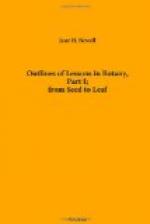Stems can be well studied from pieces of wood from the woodpile. The ends of the log will show the concentric rings. These can be traced as long, wavy lines in vertical sections of the log, especially if the surface is smooth. If the pupils can whittle off different planes for themselves, they will form a good idea of the formation of the wood. In many of the specimens there will be knots, and the nature of these will be an interesting subject for questions. If the knot is near the centre of the log, lead back their thoughts to the time when the tree was as small as the annular ring on which the centre of the knot lies. Draw a line on this ring to represent the tree at this period of its growth. What could the knot have been? It has concentric circles like the tree itself. It was a branch which decayed, or was cut off. Year after year, new rings of wood formed themselves round this broken branch, till it was covered from sight, and every year left it more deeply buried in the trunk.
Extremely interesting material for the study of wood will be found in thin sections prepared for veneers. Packages of such sections will be of great use to the teacher.[1] They show well the reason of the formation of a dividing line between the wood of successive seasons. In a cross section of Oak or Chestnut the wood is first very open and porous and then close. This is owing to the presence of ducts in the wood formed in the spring. In other woods there are no ducts, or they are evenly distributed, but the transition from the close autumn wood, consisting of smaller and more closely packed cells, to the wood of looser texture, formed in the following spring, makes a line that marks the season’s growth.
[Footnote 1: Mr. Romeyn B. Hough, of Lowville, N.Y., will supply a package of such sections for one dollar. The package will consist of several different woods, in both cross and vertical section and will contain enough duplicates for an ordinary class.
He also issues a series of books on woods illustrated by actual and neatly mounted specimens, showing in each case three distinct views of the grain. The work is issued in parts, each representing twenty-five species, and selling with text at $5, expressage prepaid; the mounted specimens alone at 25 cts. per species or twenty-five in neat box for $4. He has also a line of specimens prepared for the stereopticon and another for the microscope. They are very useful and sell at 50 cts. per species or twenty-five for $10.]




